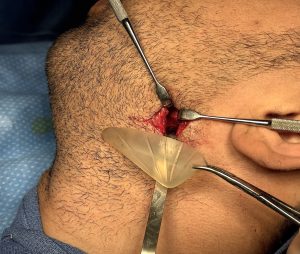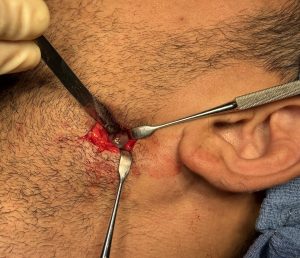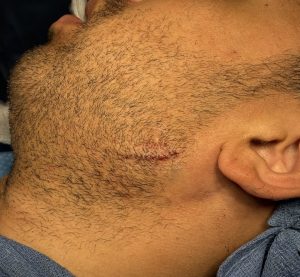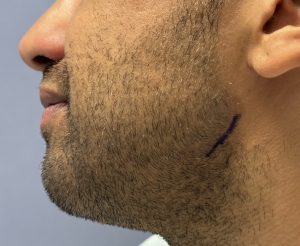Jaw angle implants have become increasingly popular, particularly amongst men, for enhancement of the back part of the lower jaw. While often in combination with chin implants or a sliding geniplasty for a more complete jaw augmentation effect, they can also be done by themselves if adequate chin projection already exists. Jaw angle implants are unique different from chin implants in numerous ways including being a paired or bilateral procedure, requiring implant placement underneath the thick masseter muscle and, as a result, causing some temporary mouth opening restriction.
The other unique feature of jaw angle implants is that they are exclusively placed through an intraoral approach. While this provides a scar free method of placement it also causes a placement issue that is almost always unrecognized. The working end of the implant (angle point) through an intraoral approach can not be seen and, as a result, their placement is a bit blind. Seeing only the top part of the implant through the incision it is impossible to completely know exactly how the implant is sitting in the bone. This explains the relatively high rate of jaw angle implant malpositon and asymmetry.
But there are indications where an external or percutaneous approach to jaw angle implant placement is warranted. In reimplantation of jaw angle implants that have a history of infection and in men (because of their beard skin) the external approach may be acceptable/preferred in an effort to lower a secondary infection risk. While an external approach to the jaw angles is well known and has been used for many decades, the placement of aesthetic implants to the jaw angles is different.



The important elements of this direct approach to jaw angle implant placement is: 1) a small direct incision over the back end of the jaw angles, 2) a blunt dissection down to the masseter muscle which creates a tunnel entrance, 3) a wide subperiosteal undermining of the muscle fibers some of which is blind once behind the back end of the jaw angle and 4) single screw fixation. The limited approach works almost exclusively with silicone implants as they can pass through tunnels that are more narrow than they are. Rigid implants are going to require either a much longer incision either over the jaw angles or in the more conventional Risdon incision location.
Dr. Barry Eppley
World-Renowned Plastic Surgeon




